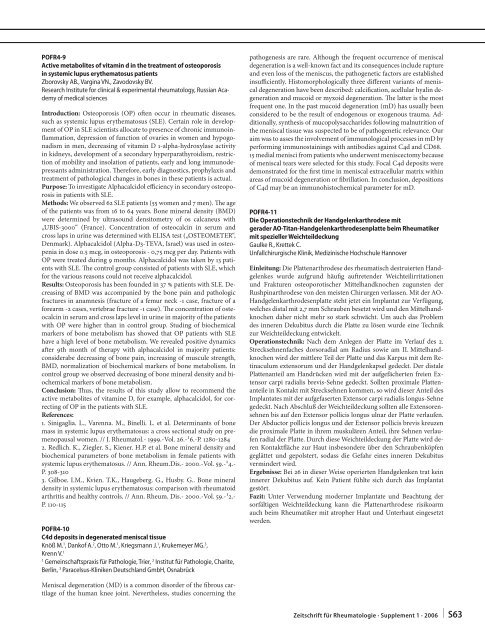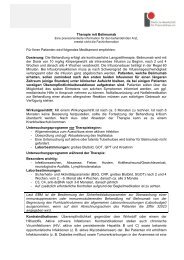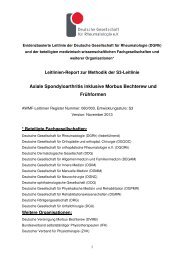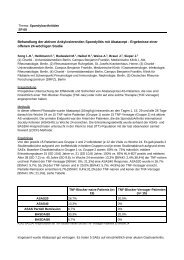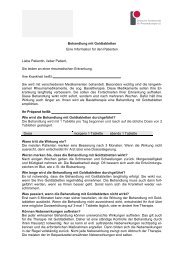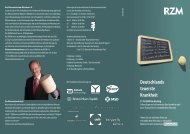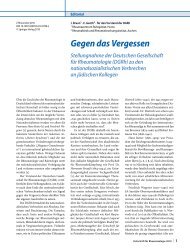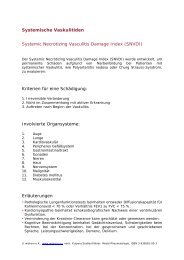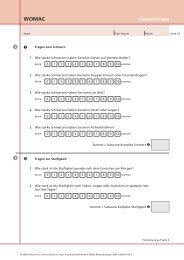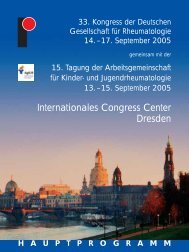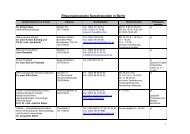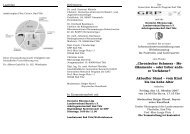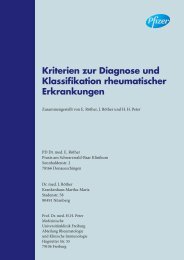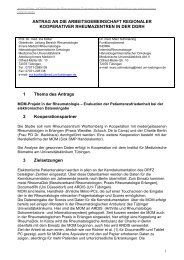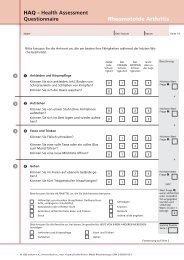Zeitschrift für Rheumatologie – Supplement 1 - Deutsche ...
Zeitschrift für Rheumatologie – Supplement 1 - Deutsche ...
Zeitschrift für Rheumatologie – Supplement 1 - Deutsche ...
Sie wollen auch ein ePaper? Erhöhen Sie die Reichweite Ihrer Titel.
YUMPU macht aus Druck-PDFs automatisch weboptimierte ePaper, die Google liebt.
POFR4-9<br />
Active metabolites of vitamin d in the treatment of osteoporosis<br />
in systemic lupus erythematosus patients<br />
Zborovsky AB., Vargina VN., Zavodovsky BV.<br />
Research Institute for clinical & experimental rheumatology, Russian Academy<br />
of medical sciences<br />
Introduction: Osteoporosis (OP) oft en occur in rheumatic diseases,<br />
such as systemic lupus erythematosus (SLE). Certain role in development<br />
of OP in SLE scientists allocate to presence of chronic immunoinfl<br />
ammation, depression of function of ovaries in women and hypogonadism<br />
in men, decreasing of vitamin D 1-alpha-hydroxylase activity<br />
in kidneys, development of a secondary hyperparathyroidism, restriction<br />
of mobility and insolation of patients, early and long immunodepressants<br />
administration. Th erefore, early diagnostics, prophylaxis and<br />
treatment of pathological changes in bones in these patients is actual.<br />
Purpose: To investigate Alphacalcidol effi ciency in secondary osteoporosis<br />
in patients with SLE.<br />
Methods: We observed 62 SLE patients (55 women and 7 men). Th e age<br />
of the patients was from 16 to 64 years. Bone mineral density (BMD)<br />
were determined by ultrasound densitometry of os calcaneus with<br />
„UBIS-3000“ (France). Concentration of osteocalcin in serum and<br />
cross laps in urine was determined with ELISA test („OSTEOMETER“,<br />
Denmark). Alphacalcidol (Alpha-D3-TEVA, Israel) was used in osteopenia<br />
in dose 0.5 mcg, in osteoporosis - 0,75 mcg per day. Patients with<br />
OP were treated during 9 months. Alphacalcidol was taken by 13 patients<br />
with SLE. Th e control group consisted of patients with SLE, which<br />
for the various reasons could not receive alphacalcidol.<br />
Results: Osteoporosis has been founded in 37 % patients with SLE. Decreasing<br />
of BMD was accompanied by the bone pain and pathologic<br />
fractures in anamnesis (fracture of a femur neck -1 case, fracture of a<br />
forearm -2 cases, vertebrae fracture -1 case). Th e concentration of osteocalcin<br />
in serum and cross laps level in urine in majority of the patients<br />
with OP were higher than in control group. Studing of biochemical<br />
markers of bone metabolism has showed that OP patients with SLE<br />
have a high level of bone metabolism. We revealed positive dynamics<br />
aft er 9th month of therapy with alphacalcidol in majority patients:<br />
considerabe decreasing of bone pain, increasing of muscule strength,<br />
BMD, normalization of biochemical markers of bone metabolism. In<br />
control group we observed decreasing of bone mineral density and biochemical<br />
markers of bone metabolism.<br />
Conclusion: Th us, the results of this study allow to recommend the<br />
active metabolites of vitamine D, for example, alphacalcidol, for correcting<br />
of OP in the patients with SLE.<br />
References:<br />
1. Sinigaglia. L., Varenna. M., Binelli. L. et al. Determinants of bone<br />
mass in systemic lupus erythematosus: a cross sectional study on premenopausal<br />
women. // J. Rheumatol.- 1999.-Vol. 26.-16.-P. 1280-1284<br />
2. Redlich. K., Ziegler. S., Kiener. H.P. et al. Bone mineral density and<br />
biochemical parameters of bone metabolism in female patients with<br />
systemic lupus erythematosus. // Ann. Rheum.Dis.- 2000.-Vol. 59.-14.-<br />
P. 308-310<br />
3. Gilboe. I.M., Kvien. T.K., Haugeberg. G., Husby. G.. Bone mineral<br />
density in systemic lupus erythematosus: comparison with rheumatoid<br />
arthritis and healthy controls. // Ann. Rheum. Dis.- 2000.-Vol. 59.-12.-<br />
P. 110-115<br />
POFR4-10<br />
C4d deposits in degenerated meniscal tissue<br />
Knöß M. 1 , Dankof A. 2 , Otto M. 1 , Kriegsmann J. 1 , Krukemeyer MG. 3 ,<br />
Krenn V. 1<br />
1 Gemeinschaftspraxis <strong>für</strong> Pathologie, Trier, 2 Institut <strong>für</strong> Pathologie, Charite,<br />
Berlin, 3 Paracelsus-Kliniken Deutschland GmbH, Osnabrück<br />
Meniscal degeneration (MD) is a common disorder of the fi brous cartilage<br />
of the human knee joint. Nevertheless, studies concerning the<br />
pathogenesis are rare. Although the frequent occurrence of meniscal<br />
degeneration is a well-known fact and its consequences include rupture<br />
and even loss of the meniscus, the pathogenetic factors are established<br />
insuffi ciently. Histomorphologically three diff erent variants of meniscal<br />
degeneration have been described: calcifi cation, acellular hyalin degeneration<br />
and mucoid or myxoid degeneration. Th e latter is the most<br />
frequent one. In the past mucoid degeneration (mD) has usually been<br />
considered to be the result of endogenous or exogenous trauma. Additionally,<br />
synthesis of mucopolysaccharides following malnutrition of<br />
the meniscal tissue was suspected to be of pathogenetic relevance. Our<br />
aim was to asses the involvement of immunological processes in mD by<br />
performing immunostainings with antibodies against C4d and CD68.<br />
15 medial menisci from patients who underwent meniscectomy because<br />
of meniscal tears were selected for this study. Focal C4d deposits were<br />
demonstrated for the fi rst time in meniscal extracellular matrix within<br />
areas of mucoid degeneration or fi brillation. In conclusion, depositions<br />
of C4d may be an immunohistochemical parameter for mD.<br />
POFR4-11<br />
Die Operationstechnik der Handgelenkarthrodese mit<br />
gerader AO-Titan-Handgelenkarthrodesenplatte beim Rheumatiker<br />
mit spezieller Weichteildeckung<br />
Gaulke R., Krettek C.<br />
Unfallchirurgische Klinik, Medizinische Hochschule Hannover<br />
Einleitung: Die Plattenarthrodese des rheumatisch destruierten Handgelenkes<br />
wurde aufgrund häufi g auft retender Weichteilirritationen<br />
und Frakturen osteoporotischer Mittelhandknochen zugunsten der<br />
Rushpinarthrodese von den meisten Chirurgen verlassen. Mit der AO-<br />
Handgelenkarthrodesenplatte steht jetzt ein Implantat zur Verfügung,<br />
welches distal mit 2,7 mm Schrauben besetzt wird und den Mittelhandknochen<br />
daher nicht mehr so stark schwächt. Um auch das Problem<br />
des inneren Dekubitus durch die Platte zu lösen wurde eine Technik<br />
zur Weichteildeckung entwickelt.<br />
Operationstechnik: Nach dem Anlegen der Platte im Verlauf des 2.<br />
Strecksehnenfaches dorsoradial am Radius sowie am II. Mittelhandknochen<br />
wird der mittlere Teil der Platte und das Karpus mit dem Retinaculum<br />
extensorum und der Handgelenkapsel gedeckt. Der distale<br />
Plattenanteil am Handrücken wird mit der aufgefächerten freien Extensor<br />
carpi radialis brevis-Sehne gedeckt. Sollten proximale Plattenanteile<br />
in Kontakt mit Strecksehnen kommen, so wird dieser Anteil des<br />
Implantates mit der aufgefaserten Extensor carpi radialis longus-Sehne<br />
gedeckt. Nach Abschluß der Weichteildeckung sollten alle Extensorensehnen<br />
bis auf den Extensor pollicis longus ulnar der Platte verlaufen.<br />
Der Abductor pollicis longus und der Extensor pollicis brevis kreuzen<br />
die proximale Platte in ihrem muskulären Anteil, ihre Sehnen verlaufen<br />
radial der Platte. Durch diese Weichteildeckung der Platte wird deren<br />
Kontaktfl äche zur Haut insbesondere über den Schraubenköpfen<br />
geglättet und gepolstert, sodass die Gefahr eines inneren Dekubitus<br />
vermindert wird.<br />
Ergebnisse: Bei 26 in dieser Weise operierten Handgelenken trat kein<br />
innerer Dekubitus auf. Kein Patient fühlte sich durch das Implantat<br />
gestört.<br />
Fazit: Unter Verwendung moderner Implantate und Beachtung der<br />
sorfältigen Weichteildeckung kann die Plattenarthrodese risikoarm<br />
auch beim Rheumatiker mit atropher Haut und Unterhaut eingesetzt<br />
werden.<br />
<strong>Zeitschrift</strong> <strong>für</strong> <strong>Rheumatologie</strong> · <strong>Supplement</strong> 1 · 2006 | S63


